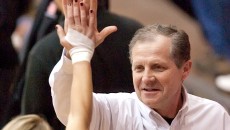Practice Preparation by Terry Liskevych
* Volleyball Magazine March/April 1977 *

The primary concern of every coach should be producing changes in behavior, specifically his player’s behavior on the volleyball court. That change will hopefully be the player’s improved ability to preform volleyball skills. This improvement is a direct result of the effectiveness of the coach’s planned practice program, which includes all of the physical training, theory and practice sessions to which he exposes his team.
My coaching philosophy stresses that the play aspect of competition is the final reward fro the hard work of practices sessions. Competent performance of the elements of the sport –not merely victory – is the source of enjoyment and fulfillment. Needless to say, a team cannot produce in a game what they haven’t attempted and drilled in practices.
Certainly there will be several differences between a practice and a game. These differences can be attributed to the extra “high” or “adrenalin” that we experience in the game situation, which causes us to jump a little higher, hit the ball a little harder or perhaps give a “110 percent” effort during a defensive play. There are many causes for these highs: the crowd, a championship, peer approval, and so on. Nevertheless, what happens in practice sessions is the key to good game performance.
Unfortunately, many coaches feel that the major key to success is their control of the action during the actual game situation. A crucial time-out, a critical substitution or a change in strategy are all important, but only if a team is well prepared. The coach’s main job is to train and prepare the team both physically and mentally prior to that first serve of the match.
Thus, the coach must plan all his/her training drills with game situations in mind. Some drills must be general to include all possibilities, whereas other drills must be very specific so that instant, precese repsonses can be masterd. For example, running offense play patterns (such as cross patterns) 30 times successfully for five consecutive practices can almost ensure the success of the cross, fake cross or any cross variation in the game situation immediately following the sessions.
When certain individual or team tactics (for example, forearm passing or defense patterns) are practiced in the training session, their effectiveness in the game situation is also increased. The more similar a coach can make his/her practice sessions to the specific elements of actual game situations, the higher the probability of success.
It is of critical importance to plan each practice session precisely. There are several important factors that must be considered:
YEARLY PLAN
An outline for the entire year should be prepared. Each year will involve three season: precompetitive, competitive, and post-competitive (offseason). Each session may involve different phases that include physical conditioning, individual tactics, team tactics and actual competition.
GUIDELINE FOR WEEKLY AND DAILY PLANS
Each week and each individual practice should also be carefully planned. This is best done by preparing a guideline of drills in the offseason. Under each general element of the game list several drills that wil develop the skills related to that aspect. Refer to this guideline for each week and for each individual session throughout the entire season. Plan each specific week the weekend before. Make final adjustments for each individual practice session immediately after the preceding session.
SPECIFIC PRACTICE SESSION
Of utmost importance is how to organize practice so that most of the time is spent in active learning.
Active learning includes a player:
1) contacting the ball:
2) going through specific movement or form drills, individually or in team tactics;
3) physical conditioning;
4) warm-up and warm-down
5) actually playing in scrimmage situations.
Active learning does not include:
1) managerial time – time the coach uses for explaining drills, giving directions and keeping order;
2) non-active learning – lecturing, instructing or demonstrating by the coach while the player listens and or observes;
3) awaiting one’s turn in a drill
4) ball shagging
5) rest or drinking time
Each individual player should have a minimum of 65 percent active learning during each practice session.
ADDITIONAL POINTS
- Set up and control practices so that the precise measurable goals that you planned prior to practice are attained. Write down these behavioral objectives.
- Budget length and time of practice. There is no research that I am familiar with regarding the optimum length of time for a volleyball practice session. Some coaches subscribe to the theory of “practice till you accomplish your goals.” I like to set reasonable and achievable goals for a two-hour session. An approximate two-hour session has been most effective for my teams (and I do not say this only because gym time has been available for only two hours). As to time of practice at the same time of day in which the team will be competing. This creates a consistency in our biological time schedules.
- Always attempt to do all of your practice drills on a volleyball court (courts). This will enhance the players’ spatial orientation and kinesthetic awareness to the physical dimensions of the court and the limiting physical boundaries (such as the net, ceiling and other obstructions).
- Do not be afraid to use effective drills regularly. There is no substitute for repetition. However, for a change of pace it is important to incorporate a new drill at least every other session to break routine and monotony.
- Be careful not to overdo a popular drill. Frequently you may have a drill that generates a considerable amount of enthusiasm from the players. An inexperienced enthusiasm. Stop a drill of this nature when enthusiasm is still high, and come back to use it as a reward or change of pace in future practices.
- Don’t overuse valuable practice time just for intrasquad scrimmages. In so doing players learn to play only against their own team’s offense and defense systems – learning too few discrimination procedures. My teams have scrimmaged rarely and only in the late pre-competitive phase or in the competitive season.
- Include some form of serving and serve receiving in each practice session. These are the two most important individual tactics in volleyball.
There is no substitute for the work that goes into planning a practice
session. Just as in “get rich quick” schemes, short-cut gimmicks for practice planning result in smaller rewards at “payday.”


